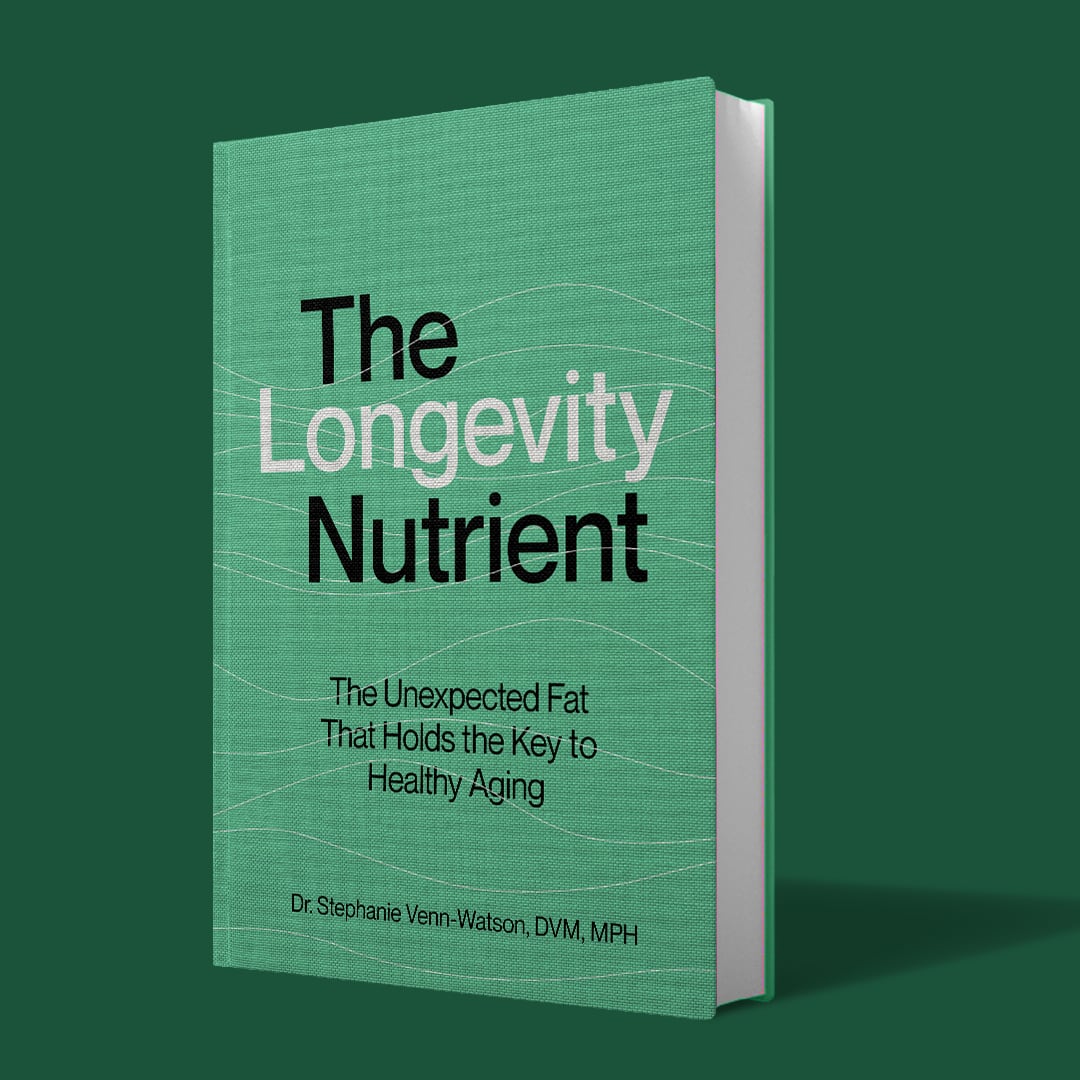Veterinary epidemiologist Dr. Stephanie Venn-Watson came to that realization in the early 2000s when she worked at the U.S. Navy. She helped uncover that the oldest dolphins had accumulated significant amounts of C15:0, or pentadecanoic acid, an odd-chain saturated fatty acid, in their bodies. Since that discovery, Venn-Watson and her colleagues have studied C15:0 and created a C15:0 supplement through Seraphina Therapeutics, a company Venn-Watson and her husband established.
C15:0 is implicated in the prevention of inflammation and even diabetes, and ongoing research connects the fat to lower rates of cognitive decline. In this interview with NutraIngredients, Venn-Watson discusses this research, findings published in her new work, ‘The Longevity Nutrient: The Unexpected Fat That Holds the Key to Healthy Aging.’ The book is in bookstores this week and is published by Simon Element.

NutraIngredients: What was the first ‘aha moment’ for you with the discovery of C15:0?
Dr. Stephanie Venn-Watson: As a veterinary epidemiologist, I was working with the Navy’s dolphins to help them continually improve their health. And because Navy dolphins live a lot longer than dolphins in the wild, we have this amazing patient population that was growing older than those in the wild. They’re living into their 40s and 50s. We were watching this geriatric dolphin population and their health over a ten-year period and finding that some, but not all, of the dolphins were susceptible to aging-related diseases like chronic inflammation and high cholesterol, fatty liver disease and even the full suite of changes consistent with Alzheimer’s. We were funded by the Navy specifically to find ways to help improve the health of aging dolphins. One way we went about doing that was to apply an advanced technology called metabolomics. We were able to access their archived serum and look for thousands of small molecules to see which small molecules could predict the healthiest aging dolphins both in their blood and in their diet. We were expecting the small molecules to be omega-3s, since all the dolphins eat are fish. Lo and behold, C15:0 was the top predictor of healthy aging for dolphins. That was a giant ‘aha moment’ where we identified this odd chain saturated fatty acid as predictor of health in the dolphins. It was from there that we then spent three years on eight studies to show that C15:0 isn’t just associated with better health, but that it is the cause that drives improved health. It’s been ten years of science and over 100 peer-reviewed papers now on C15:0 benefits. However, it was that first moment with the dolphins that really led to something worth looking into.
NI: How much did we know about C15:0 prior to your research and your colleagues' research?
SV: C15:0 has been known since the 1950s, and it’s present at such low levels. It’s a saturated fat that was assumed to have no benefit to people. For a long time, C15:0 has been used as a biomarker of how much dairy fat we eat. Dolphins were getting it from some types of fish, but we get it primarily from dairy fat. It is such a reliable source of our C15:0 that it’s long been served as a biomarker of how much dairy fat we eat.
NI: As a society, we have gotten rid of fat from dairy sources. Who thought that was a great idea?
SV: We have a wonderful chapter about this really fascinating story in the ‘Longevity Nutrient.’ There was a committee in Congress who came up with recommendations to lower the amount of saturated fat in our diet. They said then that the primary way to do that is to decrease our intake of whole dairy fat milk and butter. Those are two primary sources of C15:0. Ten years prior to that legislation there had been an alarming rise in heart disease and especially in older men. And the studies were showing that saturated fat increased LDL cholesterol. That led to these recommendations. Interestingly, by the time those recommendations were written, heart disease had actually been on the decline, partly because cigarette smoking had been on the decline.
We now know that there’s a difference between good and bad saturated fatty acids and the odd chain saturated fats, especially C15:0. This Goldilocks fatty acid is not only good for our health. It is essential. The first essential fatty acid to be discovered in 90 years.
Biological age
NI: In the book you discuss longevity must-haves. Could you go into some detail about these?
SV: They have to do with tapping into the human longevity pathway. This is a pathway that’s been determined through caloric restriction and lots of models. Scientists have figured out how caloric restriction reliably extends longevity. This pathway is at the heart of it and is the ability for C15:0 to activate AMPK and inhibit mTOR. Metformin activates AMPK. Rapamycin inhibits mTOR. But what we also know is that C15:0 targets six hallmarks of aging. There is another study that came out last year that looked at epigenetic clocks and shows that people who have higher levels of C15:0 in their lipids have a younger biological age than their chronological age. Using these epigenetic clocks are really exciting. C15:0 shows it can provide clinically relevant benefits within months.
NI: You talk about rapamycin in the book. What are some of your concerns about rapamycin as a longevity drug?
SV: Rapamycin has all these wonderful attributes of being anti-inflammatory, antioxidant, anti-cancer, anti-fibrotic and antimicrobial. It has repeatedly shown the ability to extend longevity in animals. The problem with it is that it comes with a massive list of side effects. I wrote a paper with a colleague in which we compared C15:0 to rapamycin, metformin and other leading longevity molecules. And what we showed was that C15:0 has that same list of attributes such as anti-inflammatory, antioxidant, anti-fibrotic, and even antimicrobial and anticancer without the side effects.
NI: Is assessing biological age an important litmus test to determine if someone may be helped by C15:0 supplementation?
SV: Assessing one’s biological age is the core to understanding how C15:0 works. We’re not going to be able to change our chronological age, but we can change our biological age. One well-accepted measurement of biological age is called red blood cell distribution width, or RW. It shows how much variation our red blood cell sizes are. And it’s an indication that our cells are not healthy, are becoming too fragile, and we’re having to recycle our fragile red blood cells and then bring in new ones. This is what’s happening throughout the body. Our cells are becoming too fragile. As that happens, we age faster. We know one of the core roles of C15:0 is reflected in a lowered RW, basically helping to stabilize those cells.
NI: Can you explain what some of your surprising findings were regarding fish oil and maybe some of the possible downsides of it?
SV: The challenge with fish oil supplements is that the molecule of omega-3 molecules are fragile, while C15:0 has no double bonds in it, making it incredibly sturdy and resistant to lipid peroxidation. When they become less effective, they end up having less EPA and less DHA in the bottle because the omega-3s become oxidized.
NI: What is C15:0’s connection to diabetes?
SV: The most surprising finding was when we were first assessing C15:0’s ability to help improve metabolism. We were seeing this indication in dolphins. Dolphins with age can develop insulin resistance, and the higher C15:0 they had, the less likely they were to have insulin resistance, fatty liver disease, etc. When we first tested pure C15:0, it was in a mouse model of type 2 diabetes and obesity. In 12 weeks, it lowered glucose, lowered inflammation, the mouse gained less weight on the high fat diet. I mean it was really remarkable and surprising that it was able to do that under those conditions.
NI: You talk as well about cannabis and its relationship to C15:0. Why is that important?
SV: One thing that really stood out as remarkable is that C15:0 fully activated cannabinoid one and two receptors. This was huge at the time. We published that work in 2022 because it ended up being the second discovered full-acting endocannabinoid, which then helped to explain its ability to promote better sleep, calmer mood, less pain. And we see about 50% of people report these benefits within two weeks of taking C15:0. Seventy-two percent report seeing or feeling benefits within 16 weeks.
NI: Before we wrap up the interview, is there anything else you would like to add that wasn’t mentioned earlier?
SV: It’s been a 20-year journey, and it is wonderful to be in a situation that when science holds, and the best experts are in place, that new ways of thinking can unfold. We can still make big differences with simple discoveries like this, and thanks to the dolphins.



